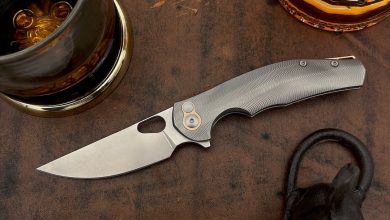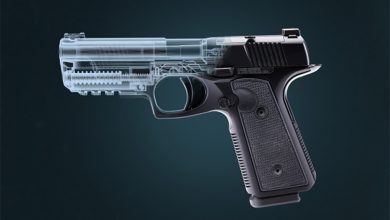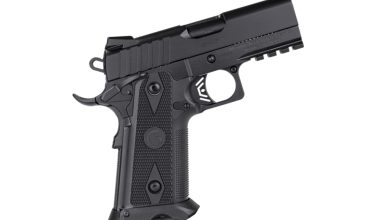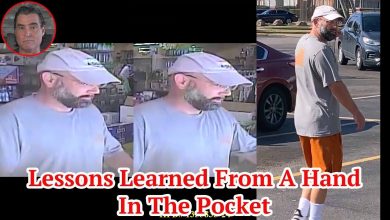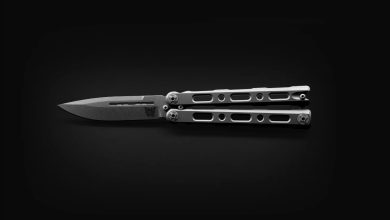TFB Review: Schmidt & Bender 3-20×50 PM II Ultra Short Riflescope
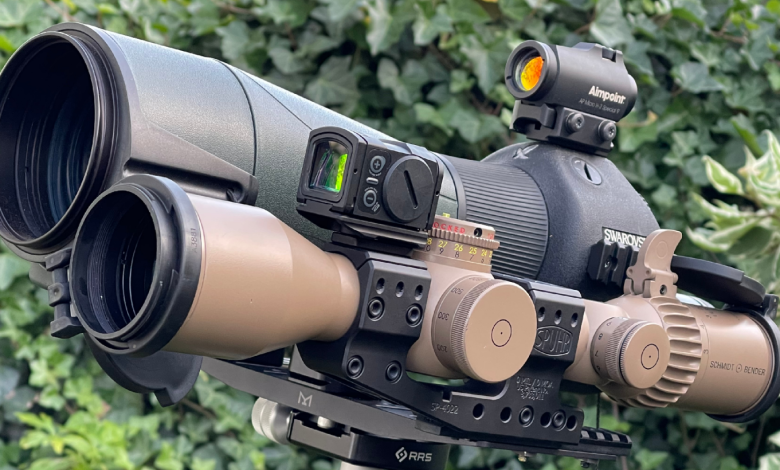
This is a review of the Schmidt & Bender 3-20×50 PM II Ultra Short riflescope, as a part of my mission to review all of the PM II models. I am very fond of the Schmidt & Bender 5-20×50 PM II Ultra Short, which is a perfect fit if you want to make your quality AR platform perform better. I own one, and I kind of wanted (at least) one more. Enter the Schmidt & Bender 3-20×50 PM II Ultra Short, which attracted me with its larger magnification range.
Schmidt & Bender @ TFB:
Let’s make a review, and find out what kind of performance it can deliver! S&B had a few contract overruns, from the Canadian C20s’ trials custom Cerakoted in Coyote M17 TAN. Two of my friends ended up buying one each, so that’s what you’re looking at in this review.
The normal length 3-20×50 PM II was originally made for the German Army, as a DMR (Designated Marksman Rifle) solution. This scope has also been adopted by other military units, but more wants more so there was a demand for a 7x zoom ratio made as compact as possible. S&B managed to shorten the 3-20×50 PM II objective bell with about 4cm/1,57inch, and that is how the current 3-20×50 PM II Ultra Short – with identical optical parameters – was born.
Short, Shorter, Ultra Short…

Some thoughts about the TREMOR reticle
When it comes to the Tremor reticle, I had some discussions with ”some friends in the business”, and according to statistics (sorry, no hard facts were presented) 80-90% of the ”problems” are solved within the area marked RED, against targets marked GREEN. The shooting becomes more urban, and ID the target and a quick hold-over is the only thing there’s time for. There’s extremely seldom time or a need to calculate extreme ballistic solutions. One of the friends sent me this image, which is a great discussion point. (It’s beyond the point, but the chimney is at around 1250 meters, way too far for most calibers.)
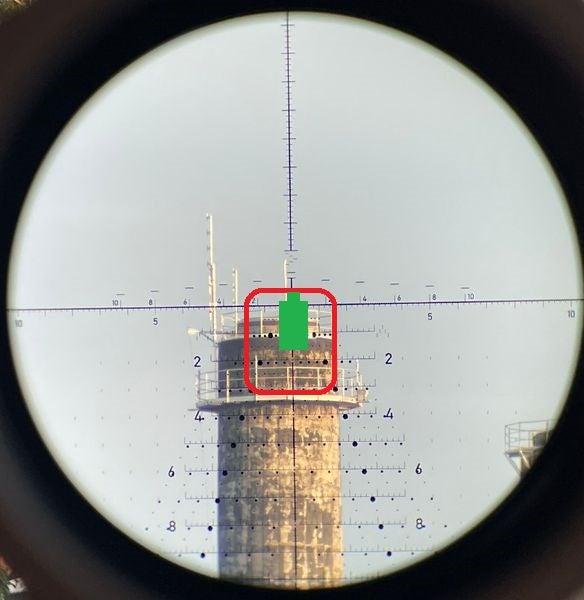
In reality, the resolution is way better than this iPhone image that has been processed a few times. I was aiming at black patches less than 1×1 inch without issues, I just hoped that my accuracy was a bit better at the time (dirty gun) and for a lot less wind. This is from when I confirmed my zero before my DMR competition.
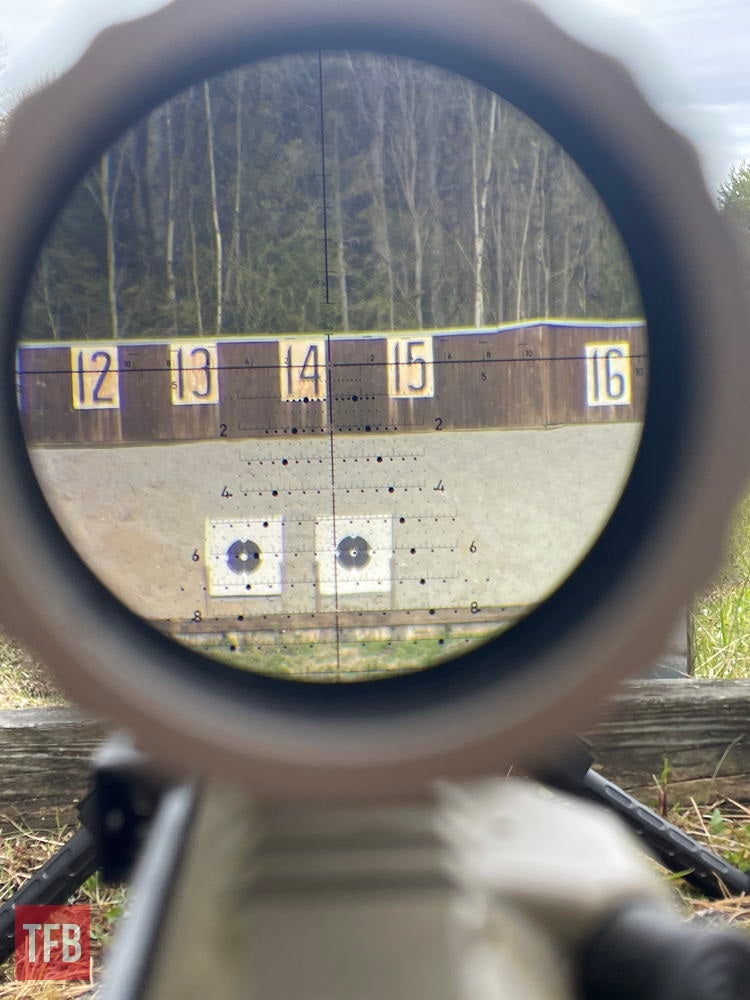
The Tremor reticle makes life pretty cluttered. Luckily it works quite well in practice, but it’s like having several reticles in one and an instruction manual with 100 pages. I only really care for the MILs.
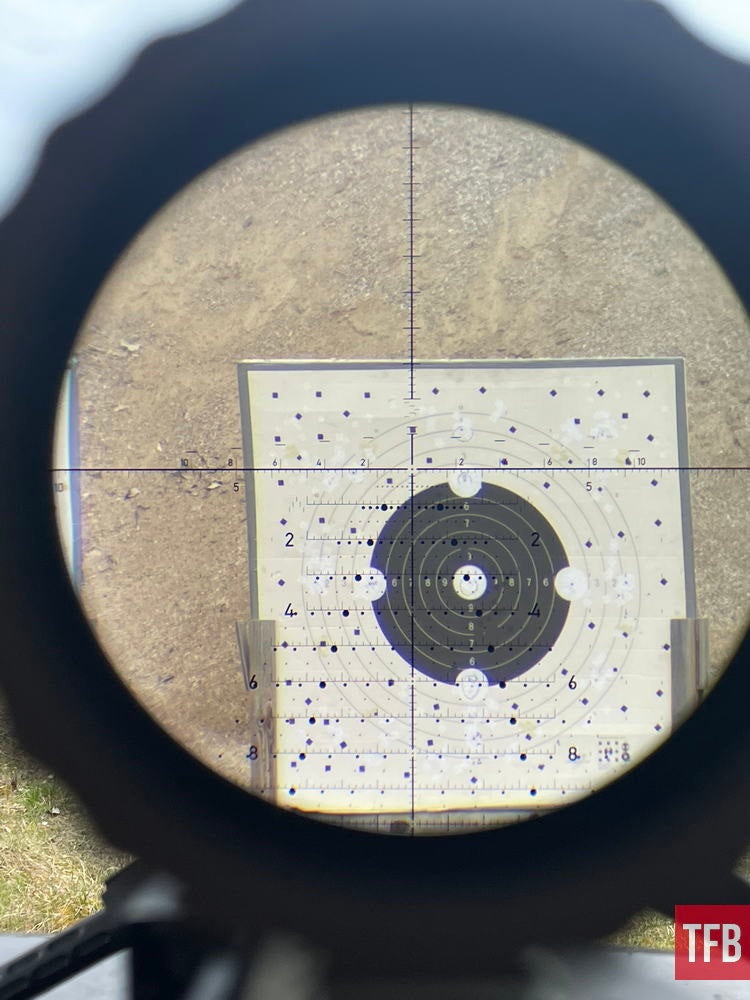
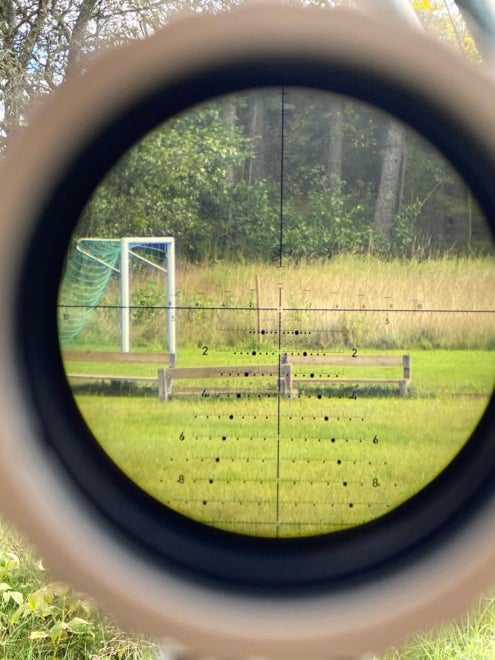
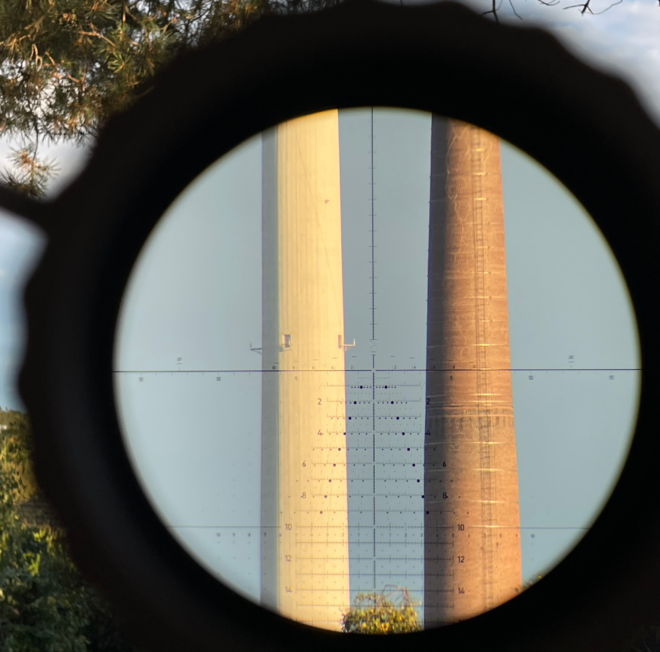
It’s probably no coincidence that a lot of these professional rifles come equipped with Schmidt & Benders, a lot of armies buy them in similar configurations.
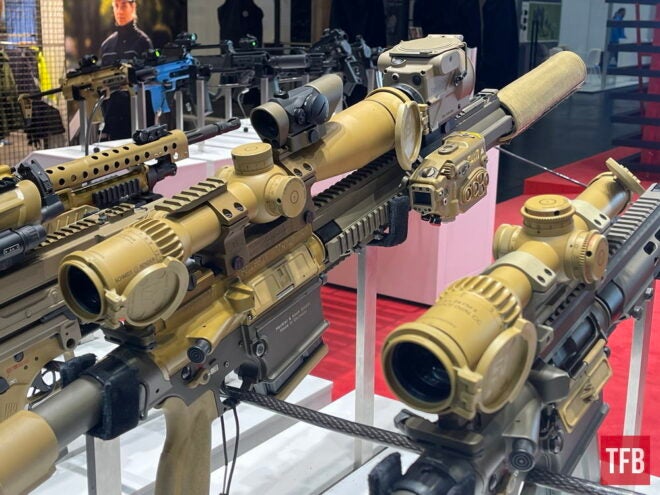
Images from EnforceTac 2024.
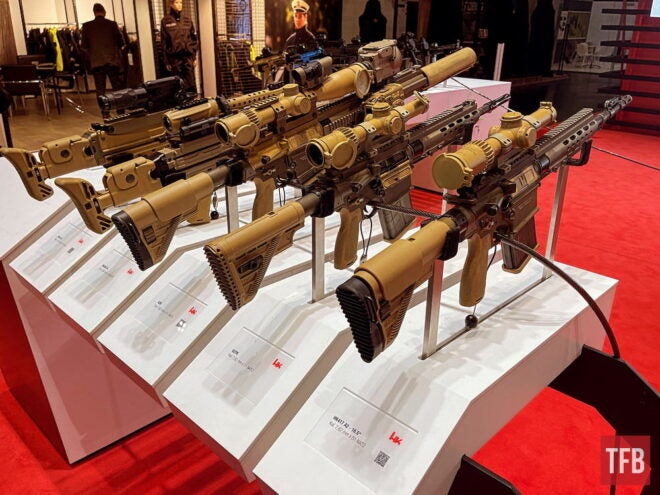
While discussing special colors for Schmidt & Benders, this is the latest color (RAL 7005) that was displayed at EnforceTac 2024, in H&K’s stand. S&B have since released a few limited editions in this color, said to be called Mouse Grey. What do I want? I want one in OD Green for my LWRCI REPR.
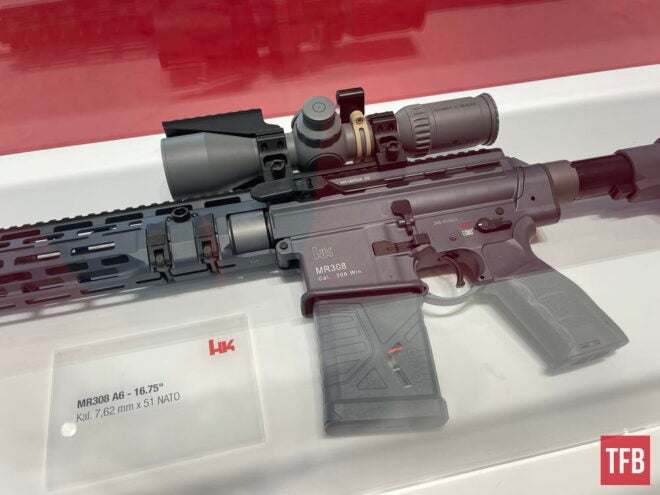
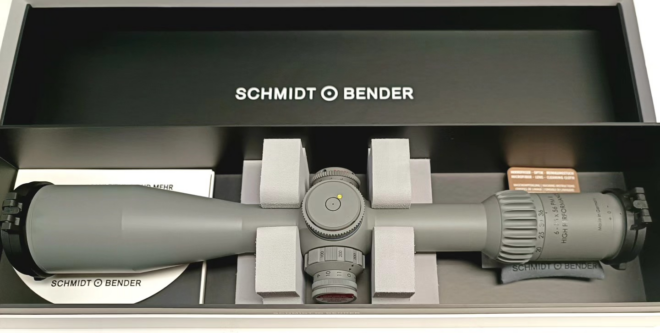
Schmidt & Bender in Mouse Grey (6-36x)
This is what my JP Rifles PCS-12 looks like competition-ready. Rebaralled into a 6.5 Creedmoor it’s about 7.2 kilograms, with a good balance without any extra weights. It goes into the Open DMR division.
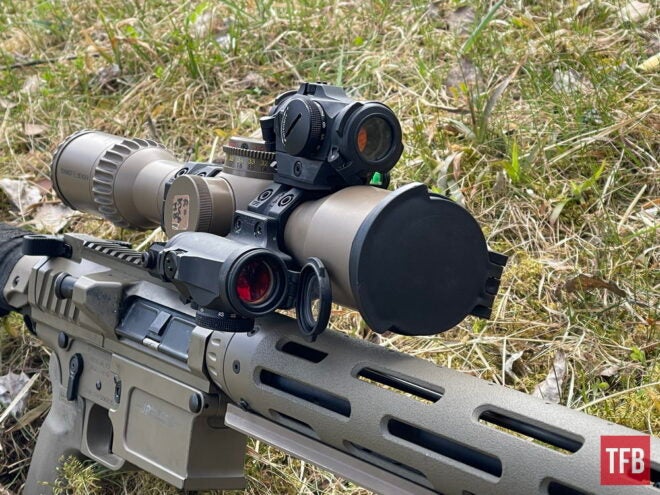
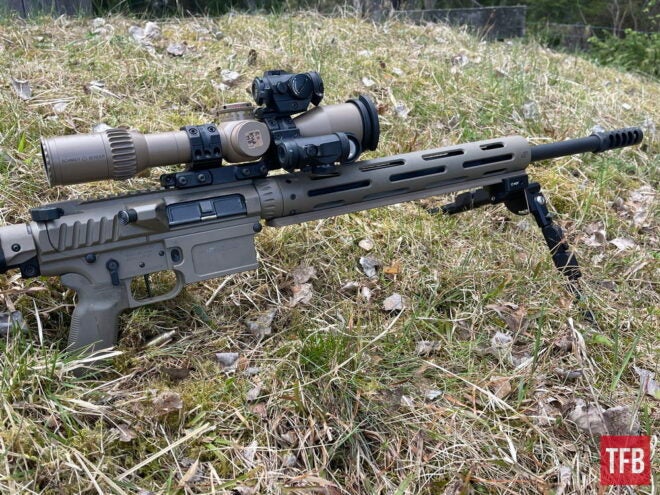
A DMR rifle for the 5.56 SA division, with an S&B 5-20x PM II Ultra Short. The bolt-action runs a ZCO 840.
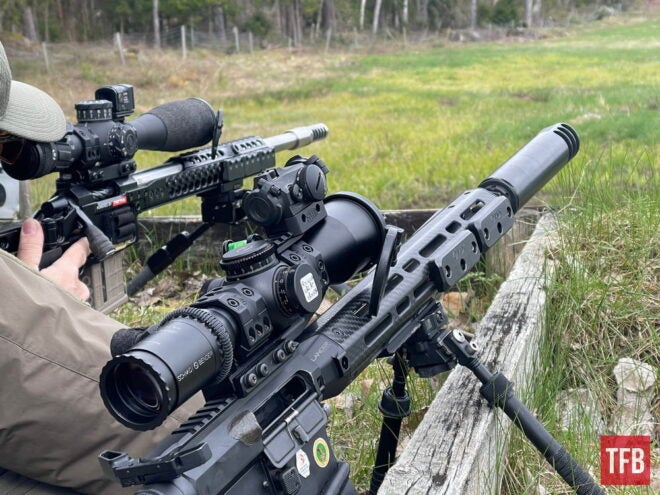
The suppressor is from A-Tec Norway and works great for PRS and DMR competitions.
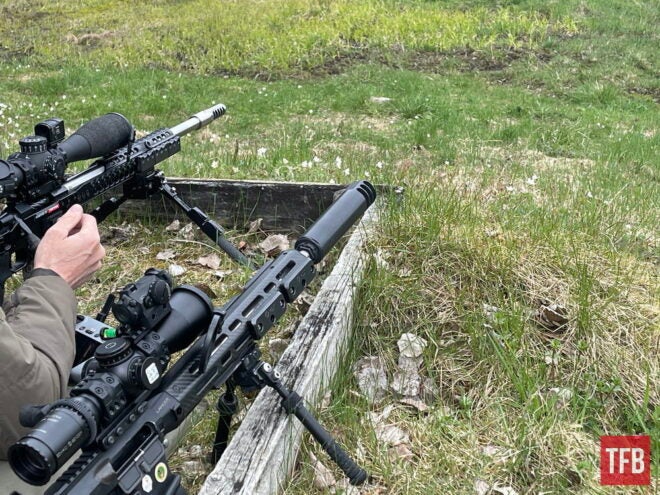
Point of view from 500 meters. I never really had any issues with the eye box, even with pretty unusual shooting positions.
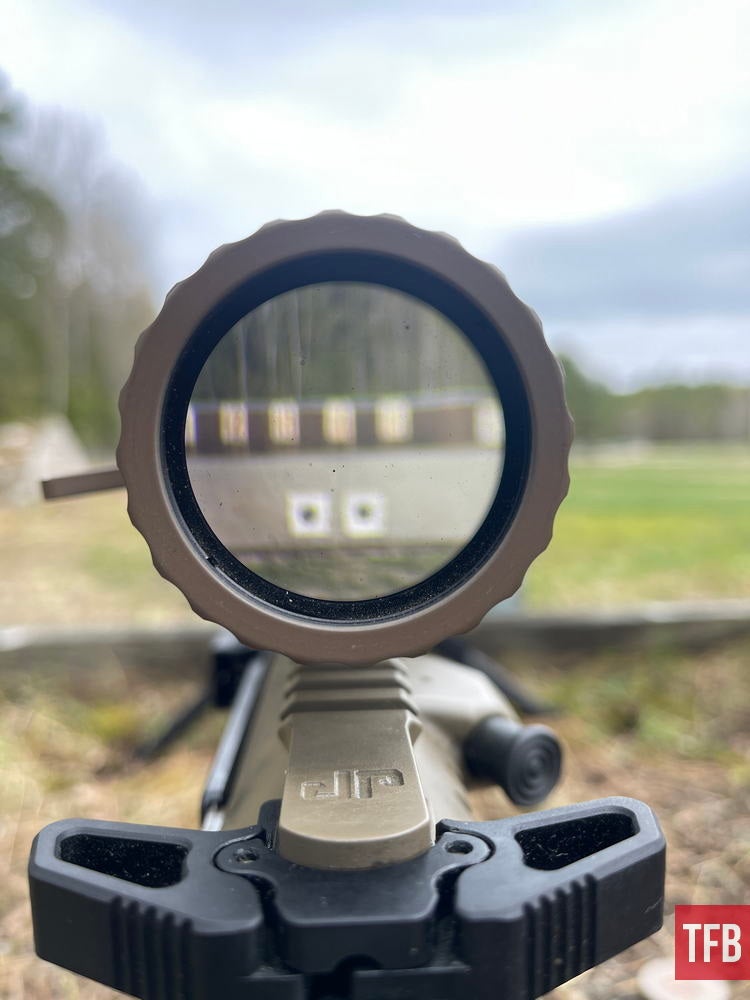
Confirming the zero before a competition at 500 meters, ringing steel of various sizes. The FMJ ammunition from Sellier & Bellot isn’t perfect, but it does its job at these distances unless the targets are really tiny (around 10 cm).
To be honest, I don’t really train anything except checking the zero before a competition. Perhaps I should?
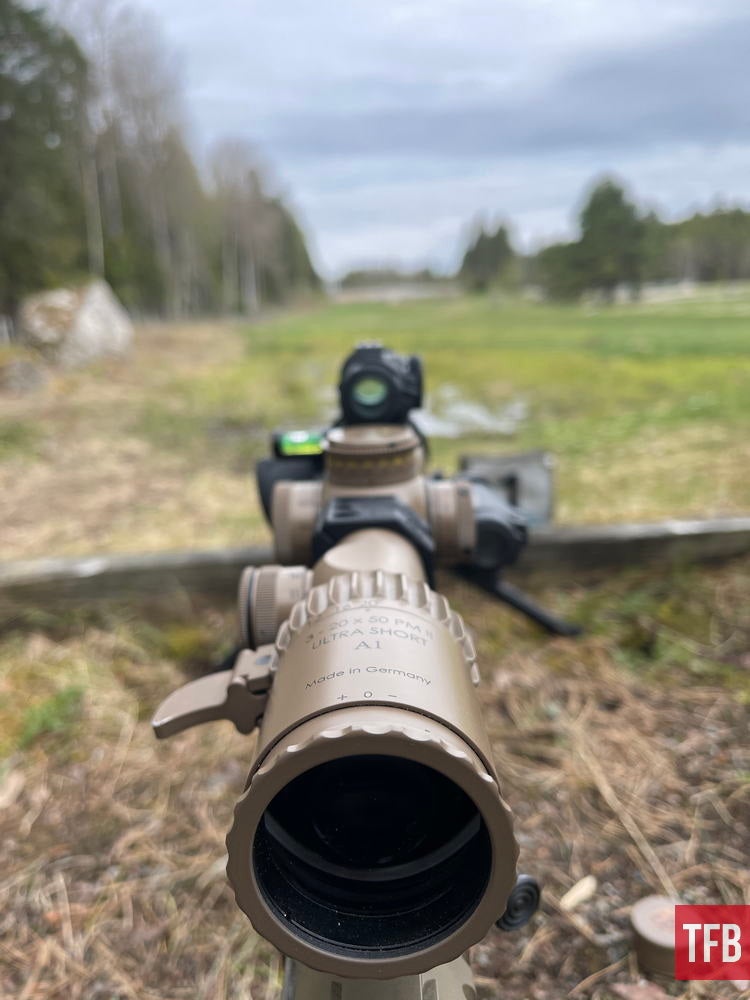
Here you can see the ”control panel”, with illumination first left and parallax in the main and center ”cross”. On top, there’s a small turret, with good tactile clicks. Partly visible to the right side is the correction for left and right, windage. This turret is capped, so I presume Canadian DMR:ers hold for wind.
The top Aimpoint is for aiming largely at the target with 1x, then you can ”sink in” into the main objective lens at 12x power or so, and engage the target without having to look for it.
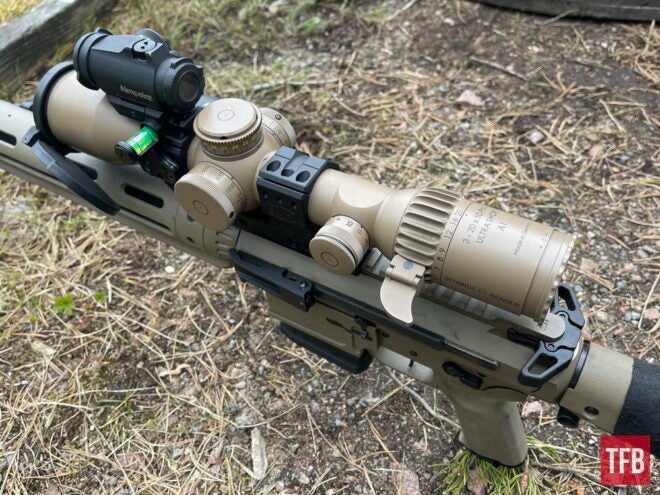
Here’s the same rifle, with the latest edition of the S&B 5-20x PM II Ultra Short. You can use a normal style mount with this scope, while the S&B 3-20x PM II Ultra Short needs a cantilever.
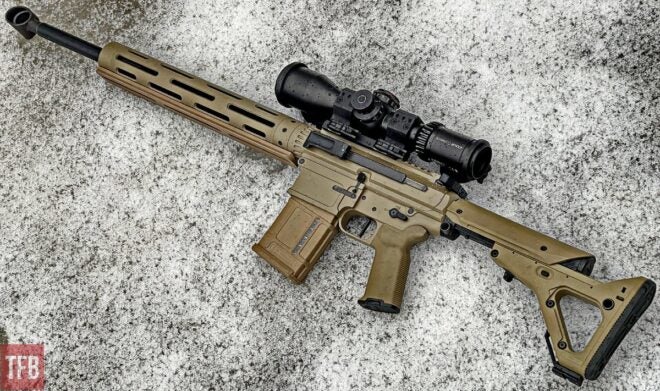
The second Aimpoint is a test we’re doing, and intended to engage targets at 20-25 meters or so, very accurately.

Here we’re getting ready to shoot at 900 meters at a 60cm round steel plate. We did hit it, but far from every time. The ammunition has its limits, and it was pretty windy over the fields.

The suppressed 556 SA did its job as well, which is pretty amazing. With 73 gr Berger bullets, it hit the steel several times and kept very close all the time. It was possible to see the trace or the impact with some good spotting scopes. The Garmin chrono worked great until it updated its firmware by itself.
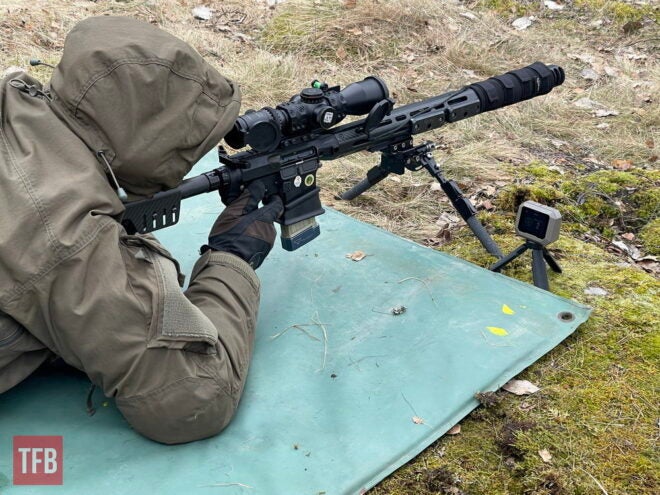
Using the Schmidt & Bender 3-20×50 PM II Ultra Short live
No review is complete without using the gear in competition, right? This year’s highlight, apart from the upcoming IPSC Rifle World Shoot, was Easthammer DMR 2024. Here’s a recap from last year’s version: Easthammer DMR Challenge 2023 – Gas Gun Precision Rifles Competition.
I managed to do much better this year and finished 4th in Open SA and 10th overall with quite a few internationally known top shooters in front of me. Partly because last year we shared the gun, and when I shot it, it malfunctioned, but mainly because I’m now much more confident with the concept of DMR and to get into position to be able to fire and hit. I still have loads to work with, so far from what’s possible. For instance, I’m not really used to running barrel up, and I still take forever to get my bag in position. This year everything with the rifle worked, and it’s all up to the shooter – just the way I like it.

Stage 1 was shooting from a Ford Estate wagon, from the inside, outside and around it. Each position has its own challenge. The safety angles were pretty tight here for good reasons, so had to move with extreme care to avoid a DQ.
Start: Sitting in driver seat with both hands on steering wheel . Rifle placed
on the back seat, muzzle pointing down range. On signal, engage targets
through back seat side window according to sequence 1. The muzzle must
be outside the vehicle before engaging targets.
Exit vehicle according to instructions shown during stage brief. Engage
targets according to sequence 1, using the hood as the primary support.
Transition to the back of the vehicle and engage the targets according to
sequence 1, using the roof as support.
Transition to prone position and engage the targets, according to
sequence 1, from the market area.
Below: …engage targets through the back seat side window… There’s a photographer to the left, and the RO is keeping a really good eye on what’s going on inside the car.
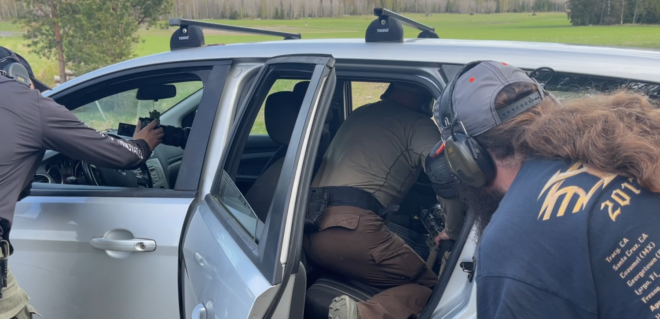
Below: …engage targets according to sequence 1, using the hood as the primary support… I chose to shoot from a bag (supplied by DRENGR Precision), note the folded bipod.
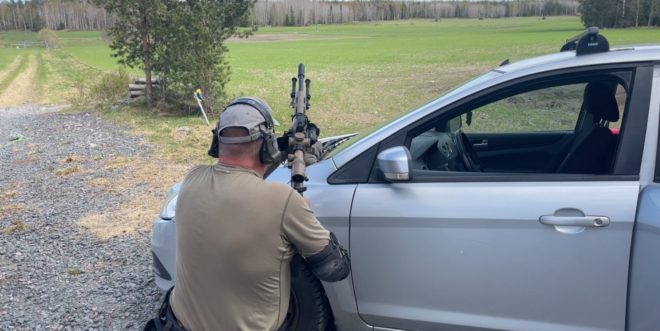
Below: …transition to the back of the vehicle… (finger is not on the trigger)

Below: …and engage the targets according to sequence 1, using the roof as support… Again using the DRENGR bag. The last position was from the ground, and I used the bipod as the main support, with the bag back.
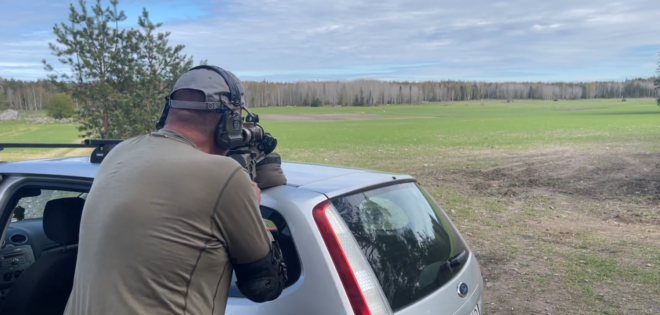
Below: Here’s another stage, where a low stone was to be used as the rifle’s main support. These low positions are killing not only me. But they could be pretty realistic in times of unpeace, with steel targets in three directions and holdovers.
You get a maximum time of around 120 seconds per stage, but if you hit all targets and finish before the set time, you get bonus fractional points per second, that eventually add up to your advantage.
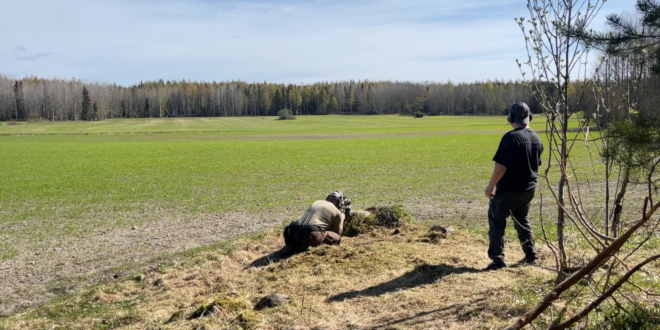
And here is my friend, who won the 556 SA division, using 73 gr Berger bullets. The riflescope is a Schmidt & Bender 5-20x PM II in a Spuhr mount. The suppressors are from A-Tec Norway.
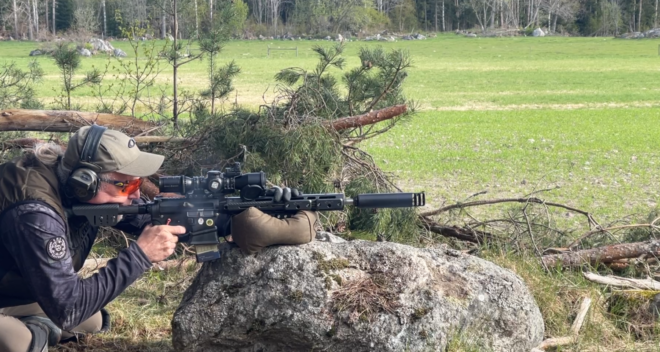
My rifle found a friend! OD Green JP Rifles with a S&B 5-45x PM II. The suppressor is from ASE Utra (Finland).
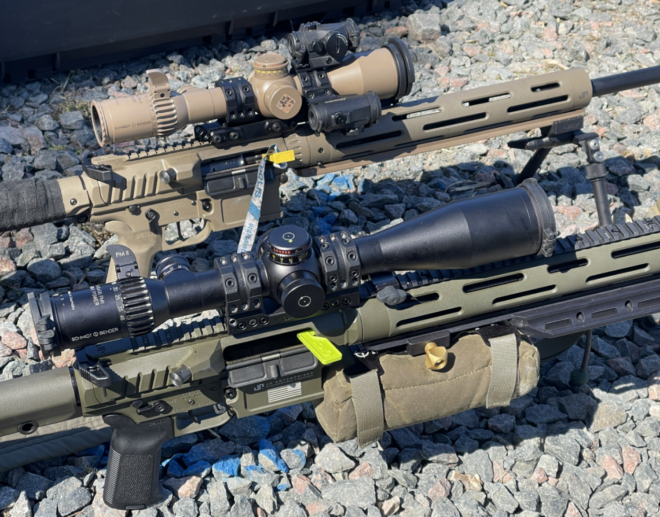
My house has always space for one more JP Rifles, and I really loved this setup with an S&B 5-45x and OD Green.

Price and availability
This riflescope should be available from many sources, and the price seems to begin around the $4,180 mark.
Conclusion
For us who believe in the power of long-range gas guns, this is a great riflescope. I’m really glad to have tried and used this riflescope in two major DMR competitions, finishing just outside the podium in the DMR Open division. I wouldn’t have chosen the Tremor reticle, but someone convinced the Canadian army (and probably a few other armies) that it’s the best there is. On the other hand, I can’t really blame the reticle for not gaining more hits and points. Luckily S&B has lots of options when it comes to specifying exactly how you want your riflescope, and the main review here is the optical quality, the mechanics and the overall design – not the reticle itself as we all have our own preferences.
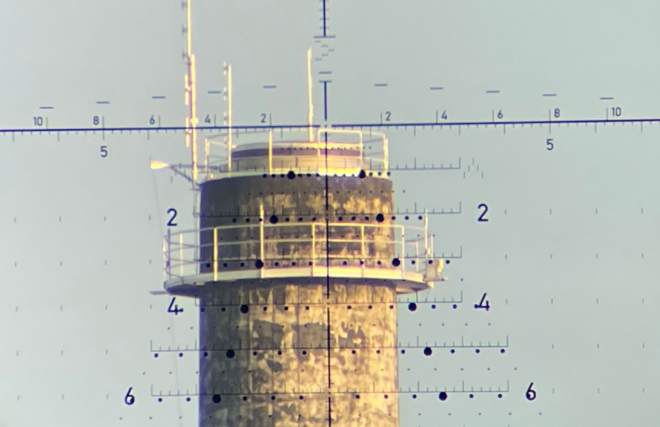
Not once during these DMR competitions, which are very relevant for what the optic wants to be, did I ever think about the eye box or anything else in fact. During the competitions, with targets between 85 to 600 meters (most being in the 300-500 meter range), I used a combination of hold-overs and clicking, all depending on what needed to be done and in which order.
It means that the riflescope must have worked! Because in reviews like these, it’s what annoys you that you remember and bring up as negatives, and I sit here a bit empty with things to tell.
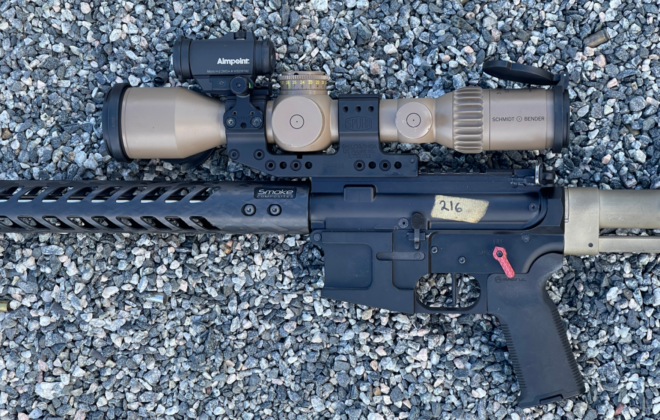
Yup, we used the S&B for PRS22 Semi Auto as well.
One thing I can complain about, and partly that could be due to me losing my eyesight year by year (I’m still in denial), is the reading of the main turret. The fact that this scope was Cerakoted (in Canada’s custom color) didn’t help at all. For sure, it isn’t as clear as the black ones (contrast) I normally use. I sometimes overtravel, hitting 2 clicks instead of 1. I know MK Machining has magnifiers to make reading of the turrets easier, and I really must try one of those out ASAP.
The illumination isn’t really daylight bright either. I personally wouldn’t mind having a much brighter center dot, but I can’t really say that it holds my shooting down.
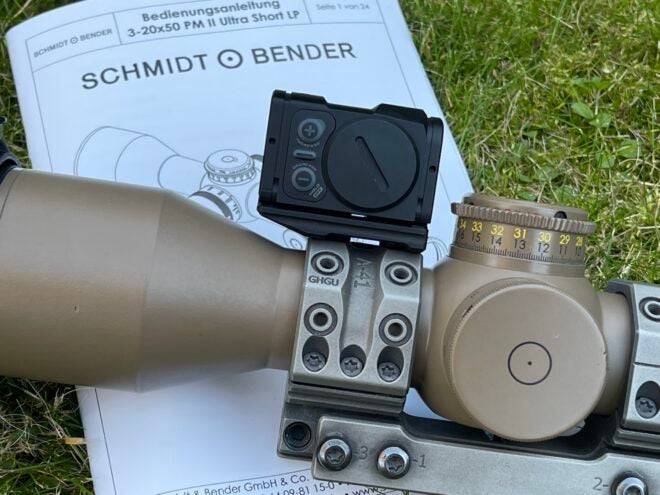
Another thing to consider is that the overall length over the 3-20x US is much more than the 5-20x US. For DMR competitions you typically work around 12-18x magnification, and NEVER below 10x, I would say. Why would you need 3x when you’re never using the 5x? Purely judging based on that, the new 5-20x PMII US would be an easy choice. Other users may have different perspectives, especially in urban areas and ”tight corners”, where you might want to transform your riflescope to an LPVO.
Keeping with the S&B brand, I would also consider the new S&B 6-36x PM II which is superb, and not that much bigger.
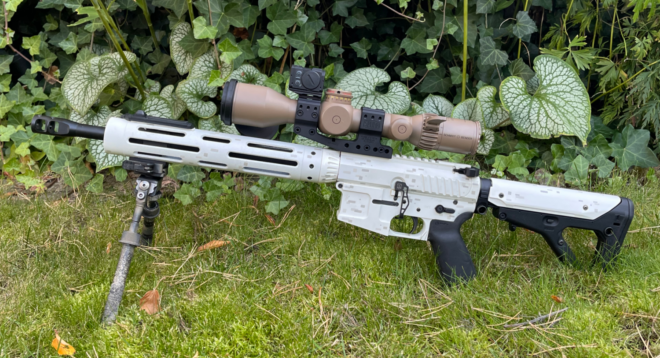
We used lots of various platforms in our review. Here is a 16″ OAL .223 Rem from JP Rifles, for when you don’t know if you’re going to the Arctic or the desert next.
In terms of optical and overall quality, there’s nothing I can really complain about, it’s pretty much a Masterpiece.
I visited the Schmidt & Bender office and factory last autumn, and it really struck me how custom-made each scope is. Not only is it Made in Germany, which has its cost, but it’s also hand-built exactly to your specifications. I actually left the factory thinking they’re cheap for the exclusivity you get. You just have to make up your mind about which S&B model suits your needs best, and I hope this article helped.
We are committed to finding, researching, and recommending the best products. We earn commissions from purchases you make using the retail links in our product reviews. Learn more about how this works.


